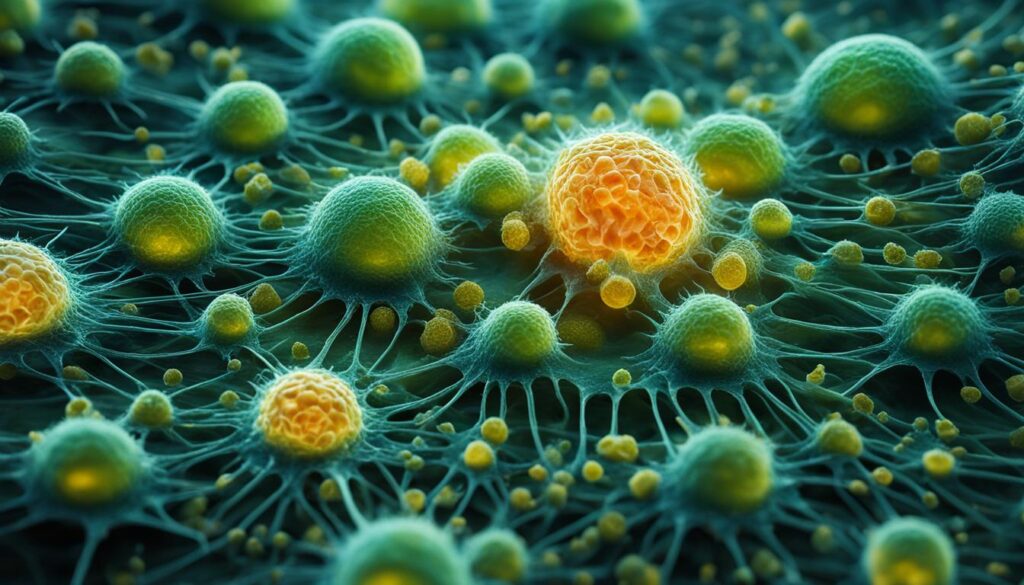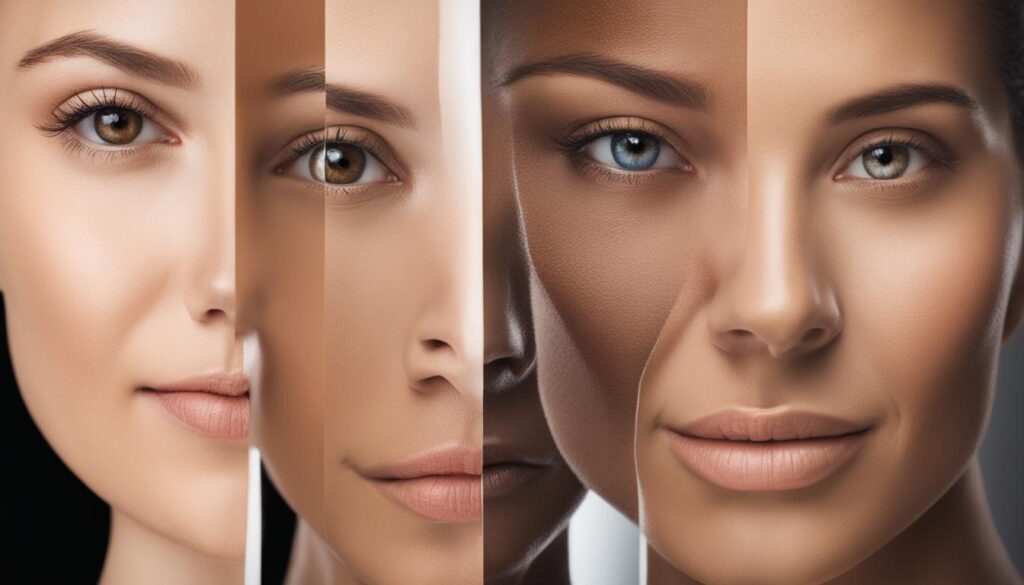As we age, our skin undergoes various changes that can leave us feeling less than confident in our appearance. Fine lines, wrinkles, age spots, and a loss of elasticity are all common signs of aging skin. However, with the help of stem cell therapy, we can now rejuvenate our skin and regain a more youthful glow.
Stem cells are unspecialized cells that have the potential to develop into various types of cells depending on their environment. When stem cells are applied to the skin, they can stimulate the production of collagen, which is essential for maintaining skin firmness and elasticity. This, in turn, can help reduce the appearance of wrinkles and fine lines, leading to a more youthful-looking complexion.
Key Takeaways:
- Stem cell therapy can help revitalize aging skin.
- Stem cells can stimulate collagen production, reducing wrinkles and fine lines.
- Stem cells are unspecialized cells with the potential to develop into various types of cells.
- Applying stem cells to the skin can improve skin firmness and elasticity.
- Stem cell therapy can help restore a more youthful-looking complexion.
Understanding Aging Skin
As we age, our skin undergoes several changes that contribute to the visible signs of aging. One of the most notable changes is a decrease in collagen production, leading to skin that is less firm and elastic. Additionally, our skin’s natural ability to retain moisture decreases, resulting in dryness and a rougher texture.
External factors such as UV exposure, pollution, and lifestyle habits (like smoking) can accelerate the natural aging process, leading to the development of fine lines and wrinkles, age spots, and other skin imperfections.
To better understand the benefits of stem cell therapy for aging skin, it’s essential to comprehend the underlying causes that contribute to skin aging.
The Natural Aging Process
As we age, our skin experiences a gradual decrease in collagen and elastin production, leading to a loss of firmness and elasticity. Skin that was once smooth and supple becomes thinner and more fragile, making it more prone to damage and injury. The skin’s natural oil production also decreases, leading to dryness and irritation.
These changes slowly become noticeable around age 30, slowly progressing as we age, leading to the visible signs of aging such as wrinkles, sagging skin, age spots, and other skin imperfections.
Factors Contributing to Aging Skin
“The sun is one of the biggest culprits of skin aging.” – Dr. Mary Johnson
The external factors that contribute to the visible signs of aging on the skin include exposure to UV radiation from the sun or tanning beds, environmental pollutants, and lifestyle factors like smoking and poor nutrition. UV radiation is the primary cause of skin aging, accounting for up to 90% of skin aging signs, including wrinkles, pigmentation, and sagging skin.
However, genetics also play a role in how our skin ages. Some individuals may be genetically predisposed to developing wrinkles and other signs of aging earlier in life.
How Stem Cell Therapy Works
Stem cell therapy offers a natural solution to rejuvenating aging skin, unlocking the regenerative properties of stem cells to promote healing and repair. The process involves extracting stem cells from your body (usually from your own fat deposits) and re-injecting them into your skin to rebuild and repair damaged tissue.
The stem cells work by stimulating collagen production, which is the key to younger-looking skin. Collagen is a protein that gives your skin its elasticity and firmness, but production slows down with age, leading to wrinkles and sagging skin.
By introducing stem cells into your skin, you can kickstart collagen production and reduce the appearance of fine lines and wrinkles. Additionally, stem cell therapy can improve skin texture and tone, creating a more youthful and radiant appearance.
It’s worth noting that the effects of stem cell therapy are not immediate and may take several weeks or months to become apparent as the stem cells work to rebuild and regenerate the skin. However, the results are long-lasting, with many patients enjoying smoother, firmer, and more youthful-looking skin for months or even years after treatment.
The Science Behind Stem Cell Therapy
Stem cell therapy is an innovative treatment that has shown tremendous potential in rejuvenating aging skin. The science behind this therapy lies in the unique properties of stem cells, which have the ability to regenerate and repair damaged tissues.
Research has shown that stem cells can promote tissue repair, regulate inflammation, and enhance the overall health of the skin. Stem cells are capable of releasing growth factors and cytokines that stimulate the production of new collagen, elastin, and other important proteins that support healthy skin.
One study conducted by Journal of Cutaneous and Aesthetic Surgery found that stem cell therapy can effectively reduce fine lines and wrinkles, as well as improve skin texture and overall skin health. The study also showed that stem cells have anti-inflammatory properties, which can help to reduce skin redness and irritation.
Another study published in Plastic and Reconstructive Surgery Journal demonstrated that stem cell therapy can help to repair sun-damaged skin. The study found that patients who received stem cell therapy had improved skin texture, decreased pigmentation, and increased hydration levels in their skin.
In summary, research has shown that stem cell therapy can be an effective treatment for aging skin. By promoting tissue repair, regulating inflammation, and enhancing overall skin health, stem cells have the potential to rejuvenate the skin and reduce the visible signs of aging.
Different Types of Stem Cell Therapy
When it comes to stem cell therapy for anti-aging purposes, there are a few different options to choose from. Here are some of the most common types:
| Type of Stem Cell Therapy | Description |
|---|---|
| Autologous Stem Cell Therapy | Stem cells are harvested from the patient’s own body, typically from bone marrow or adipose tissue, and then reintroduced via injection or topical application. |
| Allogeneic Stem Cell Therapy | Stem cells are obtained from a donor and then processed for use in another person’s body, typically through intravenous infusion. |
| Stem Cell-Infused Skincare Products | Skincare products are infused with stem cells, typically derived from plant sources like apples, and applied topically to the skin. |
Each type of stem cell therapy has its own unique benefits and limitations, and choosing the right one for your needs will depend on factors like your overall health, the severity of your aging concerns, and your personal preferences.
Whether you opt for autologous or allogeneic stem cell therapy, or choose to incorporate stem cell-infused skincare products into your routine, the natural rejuvenating power of stem cells can help you turn back the clock on aging skin.

Benefits of Stem Cell Therapy for Skin
Stem cell therapy for wrinkles is becoming increasingly popular for its numerous benefits. The regenerative properties of stem cells can promote collagen production and elastin in the skin, leading to a reduction in fine lines and wrinkles. Additionally, stem cells can improve skin tone and texture for a more youthful appearance.
In a study conducted by the International Journal of Stem Cells, patients who received stem cell therapy for skin rejuvenation reported significant improvements in skin elasticity, hydration, and overall appearance.
The Science Behind Stem Cell Therapy for Skin Rejuvenation
Stem cells have the remarkable ability to differentiate into multiple types of cells, including skin cells. When stem cells are introduced into the skin, they work to replace and repair damaged cells, leading to improved skin quality.
“Stem cells have been shown to promote wound healing, reduce inflammation, and improve tissue repair in the skin.”
But how do stem cells achieve these remarkable results? It all comes down to their unique composition. Stem cells contain growth factors and cytokines that promote cellular growth and regeneration. These factors encourage the body to naturally restore and rejuvenate the skin, leading to a more youthful appearance.
Stem Cell Therapy vs. Traditional Anti-Aging Treatments
| Treatment | Benefits | Drawbacks |
|---|---|---|
| Stem Cell Therapy | Targets the root cause of aging skin, provides long-lasting results, natural and safe | Requires a more involved treatment process, may have higher costs |
| Injectable Fillers | Provides immediate results, low cost, minimal downtime | Results are temporary, may require multiple treatments, does not address root cause of aging skin |
| Laser Therapy | Targets multiple skin concerns, provides long-lasting results, minimal downtime | May cause discomfort during treatment, may cause temporary redness and swelling |
While traditional anti-aging treatments such as injectable fillers and laser therapy can provide some benefits, they only address the visible signs of aging and do not target the root cause of aging skin. Stem cell therapy, on the other hand, works to achieve true rejuvenation of the skin by promoting cellular growth and regeneration.
Overall, stem cell therapy for skin rejuvenation is a safe and effective option for individuals looking to combat the signs of aging. Talk to your dermatologist or skincare specialist to determine if stem cell therapy is right for you.
The Procedure and Recovery Process
Stem cell therapy for aging skin and stem cell facial rejuvenation are minimally invasive procedures that do not require general anesthesia. Typically, the procedure starts with a small sample of your fat taken from your abdominal area. Then, stem cells are isolated from the sample and injected into your face or other targeted areas.
The procedure itself is relatively quick and straightforward, taking around 1-2 hours, depending on the extent of treatment required. Most patients experience little discomfort or downtime.
What to Expect After the Procedure?
After the stem cell therapy, you may experience minor swelling, bruising, or redness in the treated areas. These side effects are typically mild and resolve spontaneously in a few days.
You may also receive post-treatment advice, which includes:
- Avoiding direct sunlight – Protect your skin from the sun for at least a week after the procedure.
- No strenuous exercise – Refrain from any strenuous activity for at least a week after the procedure.
- Avoid using makeup or touching treated areas – It is best to avoid using any makeup and not touch the treated area for at least 24-48 hours after the procedure.
To get optimal results, it is recommended to follow the aftercare instructions provided by your doctor closely.

Note: Everyone’s experience may differ, and it is always advisable to consult with your doctor regarding any questions or concerns you may have regarding the procedure and recovery process.
Who is a Good Candidate for Stem Cell Therapy?
If you’re considering stem cell treatment for aging skin, it’s important to understand whether you’re a good candidate for the procedure. Generally, the ideal candidate for stem cell therapy is a healthy individual who is looking to improve the appearance of their skin.
However, some factors can affect your eligibility for the treatment. If you have a history of bleeding disorders or blood-related conditions, stem cell therapy may not be recommended. Additionally, those with an active cancer diagnosis or who are currently undergoing cancer treatment should avoid stem cell therapy.
It’s essential to consult with a qualified healthcare provider to determine whether stem cell therapy is a suitable option for you.
Factors that May Restrict Eligibility
| Medical Condition/History | Status |
|---|---|
| Bleeding disorders or blood-related conditions | Not recommended |
| Active cancer diagnosis or undergoing cancer treatment | Avoid |
Consult with a qualified healthcare provider to determine whether stem cell therapy is a suitable option for you.
Overall, stem cell therapy can be a game-changer for those looking to rejuvenate their aging skin. By understanding the factors that make an individual a good candidate, you can make an informed decision about whether this innovative treatment is right for you.
The Future of Stem Cell Therapy for Aging Skin
As research in the field of stem cell therapy continues to evolve, exciting new advancements and developments are emerging. It’s an exciting time for those interested in utilizing anti-aging stem cell therapy to rejuvenate aging skin.
Researchers are looking at different ways to optimize stem cell therapy for maximum benefits. For example, in addition to using stem cells for wrinkle reduction and skin rejuvenation, scientists are exploring the potential of stem cells in repairing sun damage, reducing age spots, and in treating skin conditions such as rosacea and eczema.
Another promising area of research is in the use of stem cell therapy in combination with other treatments, such as light therapy and microneedling. The combination of therapies may enhance the overall effectiveness of stem cell therapy and provide even greater benefits for those looking to achieve more youthful-looking skin.
“The potential of stem cell therapy for skin rejuvenation is only just starting to be discovered, and it’s an exciting time for those interested in utilizing this cutting-edge technology to fight the signs of aging.”
As stem cell research continues to advance, the hope is that the cost of stem cell therapy will become more affordable, making it a viable option for more individuals seeking anti-aging solutions.
It’s clear that the future of stem cell therapy for aging skin is bright with endless possibilities. As scientists unlock more of the secrets of stem cell therapy and its potential for skin rejuvenation, we can expect to see even more innovative treatments and exciting breakthroughs in the years to come.
Conclusion
Stem cell therapy is an exciting field that offers a range of benefits for those seeking to revitalize aging skin. Whether you are looking to reduce fine lines and wrinkles, improve skin texture and tone, or simply rejuvenate your appearance, stem cell therapy can help.
As we’ve seen throughout this article, stem cell therapy works by harnessing the regenerative properties of stem cells to stimulate collagen production, promote tissue repair, and enhance overall skin health. While there are a range of different approaches to stem cell therapy for aging skin, all have shown promising results.
Whether you choose to pursue stem cell therapy through a professional treatment or incorporate stem cell-infused skincare products into your routine, it’s clear that embracing the power of stem cells can help you achieve timeless beauty.
If you are considering stem cell therapy for aging skin, it’s important to do your research and consult with a qualified professional. With the right guidance and care, you can take advantage of the many benefits that stem cell therapy has to offer.
FAQ
What is stem cell therapy for aging skin?
Stem cell therapy for aging skin involves using stem cells to rejuvenate the skin and reverse the signs of aging. These stem cells have the ability to stimulate collagen production, reduce wrinkles and fine lines, and improve skin texture and tone.
How does stem cell therapy work to revitalize aging skin?
Stem cell therapy works by harnessing the regenerative properties of stem cells. When these stem cells are introduced into the skin, they can stimulate the production of collagen, which is essential for maintaining the elasticity and firmness of the skin. This helps to reduce the appearance of wrinkles and fine lines and improve overall skin texture.
What are the benefits of stem cell therapy for skin rejuvenation?
Stem cell therapy offers a range of benefits for skin rejuvenation. It can reduce the appearance of wrinkles and fine lines, improve skin texture and tone, promote tissue repair, regulate inflammation, and enhance the overall health and vitality of the skin.
What types of stem cell therapy are available for aging skin?
There are several types of stem cell therapy available for aging skin. These include autologous stem cell therapy, where stem cells are sourced from the patient’s own body, and stem cell-infused skincare products that contain stem cell extracts or derivatives.
Is stem cell therapy for aging skin a safe procedure?
Stem cell therapy for aging skin is generally considered safe when performed by a qualified professional. However, as with any medical procedure, there can be potential risks and side effects. It is important to consult with a healthcare provider who specializes in stem cell therapy to ensure safety and optimal results.
Who is a good candidate for stem cell therapy for aging skin?
Generally, individuals who are in good overall health and have realistic expectations are good candidates for stem cell therapy for aging skin. However, specific eligibility criteria may vary depending on individual factors and the type of stem cell therapy being considered. Consulting with a healthcare provider is essential to determine eligibility.
What can I expect during the stem cell therapy procedure and recovery process?
During the stem cell therapy procedure, stem cells will be either harvested from your body or applied topically to the skin, depending on the type of therapy being used. The recovery process can vary, but generally involves minimal downtime and discomfort. Your healthcare provider will provide specific instructions for aftercare and monitor your progress throughout the recovery period.
What does the future hold for stem cell therapy for aging skin?
The field of stem cell therapy for aging skin continues to evolve, with ongoing research and advancements. The future may bring even more innovative techniques and treatments that further enhance the effectiveness of stem cell therapy, providing even better results for those seeking to revitalize their aging skin.



